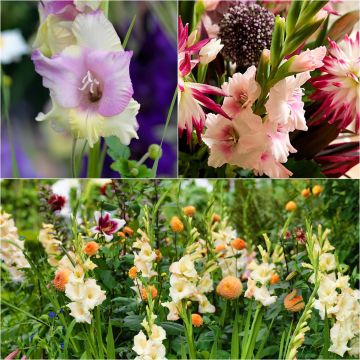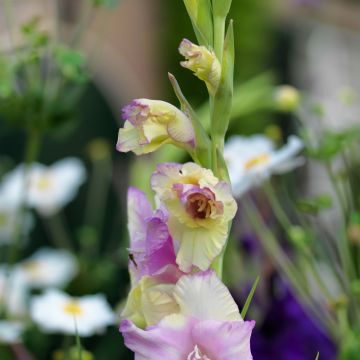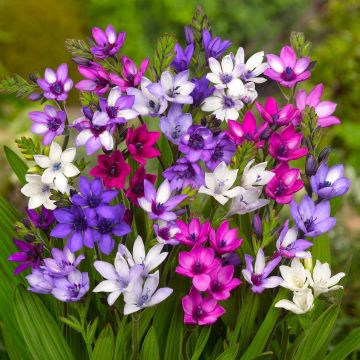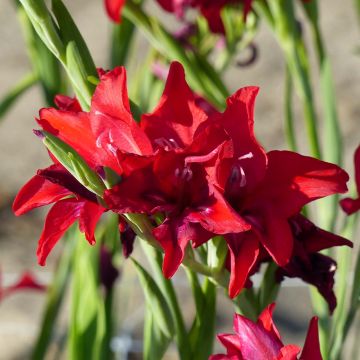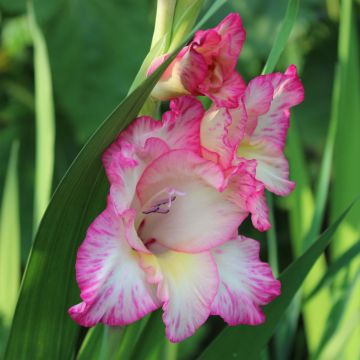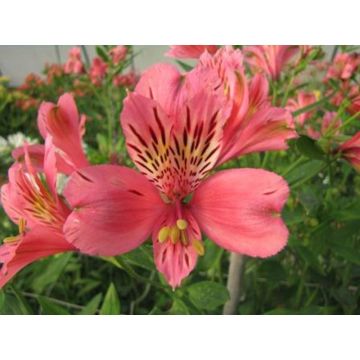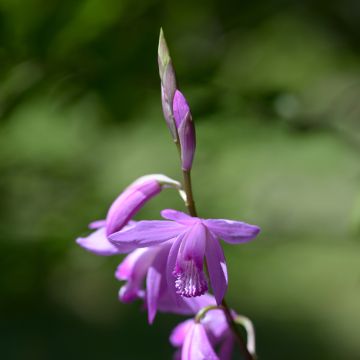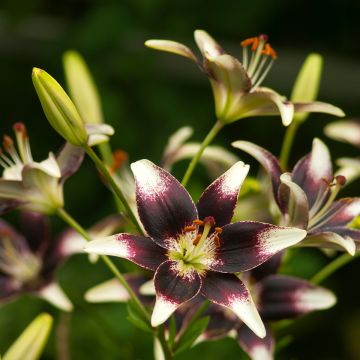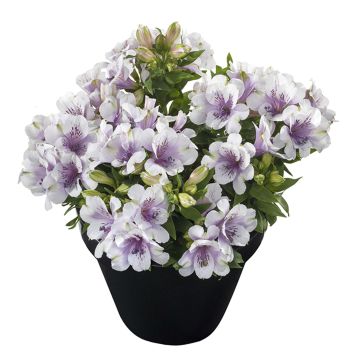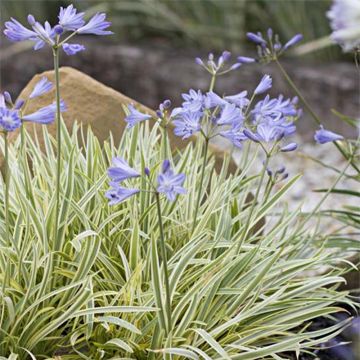

Gladiolus Lorena - Sword Lily


Gladiolus Lorena - Sword Lily
Gladiolus Lorena - Sword Lily
Gladiolus x grandiflorus (Butterfly) Lorena
Large-Flowered Gladiolus, Sword Lily
Why not try an alternative variety in stock?
View all →This plant carries a 6 months recovery warranty
More information
We guarantee the quality of our plants for a full growing cycle, and will replace at our expense any plant that fails to recover under normal climatic and planting conditions.
From €5.90 for pickup delivery and €6.90 for home delivery
Express home delivery from €8.90.
Does this plant fit my garden?
Set up your Plantfit profile →
Description
The Gladiolus or Butterfly Gladiolus 'Lorena' bears remarkably contrasting flowers, pure white with a yellow throat maculated with dark orange. A colour that doesn't go unnoticed in the garden, and flowering spikes that make a sensation in bouquets. It blooms for many weeks in summer. Rarely available for sale, this variety will be the pride of the gardener who cultivates it. We deliver them in a large size of 12+ for the best flowering.
Cultivated gladioli are hybrids, they belong to the Iridaceae family. They are divided into 3 main groups: Grandiflorus (large-flowered), Primulinus (early) and Nanus (butterflies). 'Lorena', although quite unclassifiable, can be classified as Nanus, characterised by rather small and often maculated flowers, irregularly arranged on 60 to 70 cm (24 to 28in) tall stems, each carrying up to 20 florets. The upper petal of each flower has a recurved hood-like shape.
'Lorena' is a cultivar derived, among others, from the Gladiolus papilio, a species native to the marshy and mountainous areas of the Drakensberg, in South Africa. It is a perennial and deciduous herbaceous plant with stoloniferous and tuberous roots. Its foliage consists of thin, rather short, sword-shaped leaves, green-grey in colour, arranged in a fan shape and forming a tuft about 55 cm (22in) tall. The leaves are topped by a flowering stem 90 cm (35in) to 1 m (3ft) tall, ending in a 40 cm (16in) spike with numerous buds. The hooded flowers resemble those of certain orchids, or even cannas, and are carried by very thin stems. They appear in 'Lorena' in a perfect white, each petal being traversed by a fuchsia pink spot. The two small lateral petals are coloured in tender yellow and marked by an orange to red triangle at the base. The storage organ is a corm, which is a swollen stem with scales. Each corm will produce 2 or 3 flowering spikes. The foliage of the gladiolus is deciduous, it disappears a few weeks after flowering.
The 'Lorena' Gladiolus has a great chance of changing the perception of detractors of this plant, often considered stiff and lacking elegance, to the point that it is relegated among the vegetables in the vegetable garden for cut flowers. Gladioli and their long coloured spikes are a symbol of the 70s and somewhat formal floral arrangements. While they are irreplaceable in bouquets, in gardens, their silhouette needs the presence of plants with lush foliage that will enhance their flowering. Plant 'Lorena' in beds of grasses, forget-me-nots, and perennial flax for example. Play with white for elegance and add here and there silver foliage, or bronze fennel.
For bouquet making: pick, early in the morning, gladioli that have opened two or three flowers. Leave 5 to 6 leaves per stem to allow the bulb to continue its development. Remove the first two buds at the top of the flowering spike. Plant at intervals of ten days in March/April. You will have flowers all summer.
The gladiolus owes its name to the shape of its sword-like leaves, derived from the Latin, gladius. Its wild forms were often represented in jewelry or on carpets and fabrics made by the Semites before the Christian era.
Report an error about the product description
Plant habit
Flowering
Foliage
Botanical data
Gladiolus
x grandiflorus
(Butterfly) Lorena
Iridaceae
Large-Flowered Gladiolus, Sword Lily
Cultivar or hybrid
Other Gladioli
Planting and care
The 'Lorena' Gladiolus loves rich, fertile but well-drained soils, so sandy soils are ideal. Plant it in full sun. Space the bulbs 10 to 15cm (4 to 6in) apart and cover them with 10cm (4in) of soil. Avoid using manure to fertilise the soil as it promotes bulb rot. Gladiolus bulbs are susceptible to frost, so they should be dug up when they are withered or immediately after the first frost. Cut the leaves and let them dry in a well-ventilated place for three weeks. Separate the old bulbs, store the new bulbs and bulblets throughout the winter in a cool place that is protected from frost. The bulblets will bloom in two years. It is preferable not to plant gladiolus bulbs in the same spot for several years in a row. An annual rotation will yield better results. In mild climates, corms can be planted in September-October and left in the ground over winter without damage.
Planting period
Intended location
Care
This item has not been reviewed yet - be the first to leave a review about it.
Bulbs to grow in pots
Haven't found what you were looking for?
Hardiness is the lowest winter temperature a plant can endure without suffering serious damage or even dying. However, hardiness is affected by location (a sheltered area, such as a patio), protection (winter cover) and soil type (hardiness is improved by well-drained soil).

Photo Sharing Terms & Conditions
In order to encourage gardeners to interact and share their experiences, Promesse de fleurs offers various media enabling content to be uploaded onto its Site - in particular via the ‘Photo sharing’ module.
The User agrees to refrain from:
- Posting any content that is illegal, prejudicial, insulting, racist, inciteful to hatred, revisionist, contrary to public decency, that infringes on privacy or on the privacy rights of third parties, in particular the publicity rights of persons and goods, intellectual property rights, or the right to privacy.
- Submitting content on behalf of a third party;
- Impersonate the identity of a third party and/or publish any personal information about a third party;
In general, the User undertakes to refrain from any unethical behaviour.
All Content (in particular text, comments, files, images, photos, videos, creative works, etc.), which may be subject to property or intellectual property rights, image or other private rights, shall remain the property of the User, subject to the limited rights granted by the terms of the licence granted by Promesse de fleurs as stated below. Users are at liberty to publish or not to publish such Content on the Site, notably via the ‘Photo Sharing’ facility, and accept that this Content shall be made public and freely accessible, notably on the Internet.
Users further acknowledge, undertake to have ,and guarantee that they hold all necessary rights and permissions to publish such material on the Site, in particular with regard to the legislation in force pertaining to any privacy, property, intellectual property, image, or contractual rights, or rights of any other nature. By publishing such Content on the Site, Users acknowledge accepting full liability as publishers of the Content within the meaning of the law, and grant Promesse de fleurs, free of charge, an inclusive, worldwide licence for the said Content for the entire duration of its publication, including all reproduction, representation, up/downloading, displaying, performing, transmission, and storage rights.
Users also grant permission for their name to be linked to the Content and accept that this link may not always be made available.
By engaging in posting material, Users consent to their Content becoming automatically accessible on the Internet, in particular on other sites and/or blogs and/or web pages of the Promesse de fleurs site, including in particular social pages and the Promesse de fleurs catalogue.
Users may secure the removal of entrusted content free of charge by issuing a simple request via our contact form.
The flowering period indicated on our website applies to countries and regions located in USDA zone 8 (France, the United Kingdom, Ireland, the Netherlands, etc.)
It will vary according to where you live:
- In zones 9 to 10 (Italy, Spain, Greece, etc.), flowering will occur about 2 to 4 weeks earlier.
- In zones 6 to 7 (Germany, Poland, Slovenia, and lower mountainous regions), flowering will be delayed by 2 to 3 weeks.
- In zone 5 (Central Europe, Scandinavia), blooming will be delayed by 3 to 5 weeks.
In temperate climates, pruning of spring-flowering shrubs (forsythia, spireas, etc.) should be done just after flowering.
Pruning of summer-flowering shrubs (Indian Lilac, Perovskia, etc.) can be done in winter or spring.
In cold regions as well as with frost-sensitive plants, avoid pruning too early when severe frosts may still occur.
The planting period indicated on our website applies to countries and regions located in USDA zone 8 (France, United Kingdom, Ireland, Netherlands).
It will vary according to where you live:
- In Mediterranean zones (Marseille, Madrid, Milan, etc.), autumn and winter are the best planting periods.
- In continental zones (Strasbourg, Munich, Vienna, etc.), delay planting by 2 to 3 weeks in spring and bring it forward by 2 to 4 weeks in autumn.
- In mountainous regions (the Alps, Pyrenees, Carpathians, etc.), it is best to plant in late spring (May-June) or late summer (August-September).
The harvesting period indicated on our website applies to countries and regions in USDA zone 8 (France, England, Ireland, the Netherlands).
In colder areas (Scandinavia, Poland, Austria...) fruit and vegetable harvests are likely to be delayed by 3-4 weeks.
In warmer areas (Italy, Spain, Greece, etc.), harvesting will probably take place earlier, depending on weather conditions.
The sowing periods indicated on our website apply to countries and regions within USDA Zone 8 (France, UK, Ireland, Netherlands).
In colder areas (Scandinavia, Poland, Austria...), delay any outdoor sowing by 3-4 weeks, or sow under glass.
In warmer climes (Italy, Spain, Greece, etc.), bring outdoor sowing forward by a few weeks.


































